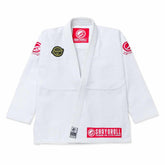Krav Maga vs BJJ: Key Differences, Effectiveness, and Real-World Use
In today’s world, choosing the right martial art is not just about learning to fight. But it is about gaining real-world self-defense skills, building confidence, improving fitness and in many cases, joining a strong community. Two of the most talked-about disciplines are Krav Maga and Brazilian Jiu Jitsu (BJJ). Both systems aim to prepare practitioners for real-life situations. However, they come from different roots and offer unique strengths.
In this guide, we will explore the key differences between Krav Maga and BJJ. Moreover, we will analyze their effectiveness in self-defense and real-world situations. Ultimately, it will help you decide which might be better suited to your goals.
What is Krav Maga?
Krav Maga is a combat system developed by the Israeli Defense Forces (IDF) for military and police use. It is designed specifically for real-world combat scenarios. Krav Maga incorporates techniques from boxing, wrestling, judo, aikid, and street-fighting. Its philosophy is simple: neutralize threats quickly and escape safely.
Key features of Krav Maga include:
- Disarming attackers (guns, knives, etc.)
- Simultaneous defense and attack
- Targeting vulnerable areas (groin, throat, eyes)
- Training under stress and exhaustion to simulate real attacks
Krav Maga is known for its brutal efficiency. Thus, making it a favorite among law enforcement and civilians seeking real-world self-defense skills.
What is BJJ (Brazilian Jiu Jitsu)?
Brazilian Jiu Jitsu, or BJJ, is a grappling-based martial art. It emphasizes technique over strength. Thus, allowing smaller practitioners to control and submit larger opponents using leverage and joint locks. BJJ basically originated from Judo. Then, it evolved in Brazil and has since become one of the cornerstones of modern MMA.
In BJJ, practitioners train with or without the Gi (BJJ Gi)—a traditional uniform that allows for grips, chokes and control. No-Gi BJJ is the variant practiced in tighter, athletic clothing, which resembles real-world clothing scenarios more closely.
Key features of BJJ include:
- Ground control and submissions
- Positional hierarchy (guard, mount, side control)
- Sport-based competition (IBJJF, ADCC, etc.)
- Deep technical progression and belt ranking
It does not matter if you are wearing a Gi or training No-Gi. BJJ offers a unique blend of physical fitness, strategy and mental discipline.
Key Differences Between Krav Maga and BJJ
| Aspect | Krav Maga | Brazilian Jiu Jitsu |
|---|---|---|
| Origin | Israel (Military) | Brazil (Sport/MMA) |
| Focus | Real-world self-defense | Grappling, ground fighting |
| Style | Striking + weapons disarmament | Takedowns, submissions, positional control |
| Training | Fast-paced, aggressive, scenario-based | Technical, progressive, often sport-oriented |
| Gi Required? | No | Yes (Gi) or No (No-Gi BJJ) |
| Competition | No formal competitions | Highly competitive with worldwide tournaments |
| Target Audience | Civilians, military, law enforcement | Athletes, hobbyists, MMA fighters |
Effectiveness in Self-Defense
Krav Maga: Real-World Self-Defense Priority
Krav Maga excels in raw, chaotic and unpredictable environments. Its techniques are built around short reaction time, disabling your attacker and getting out of danger fast. The inclusion of weapon defense and training under high-stress simulations makes it practical for street-level confrontations.
However, Krav Maga's biggest strength—its lack of rules and rawness—can also be a limitation. Without live sparring, practitioners may lack the resistance training. And it is necessary to apply techniques under pressure.
BJJ: Control Without Striking
Brazilian Jiu Jitsu takes a more measured, technical approach to self-defense. In a real altercation, a skilled BJJ practitioner can take down an aggressor. He can control them on the ground and apply a submission without causing permanent damage. This makes BJJ an ideal self-defense art in environments like schools, hospitals or any scenario where non-lethal control is critical.
Moreover, BJJ practitioners spar regularly. It means that they are used to applying techniques against fully resisting opponents—a huge advantage in real-world effectiveness.
That said, BJJ has fewer answers for multiple attackers or weapons-based threats, areas where Krav Maga might offer more complete solutions.
Real-World Use Scenarios
Let’s break down a few real-life situations and see how both systems perform:
Street Fight (One-on-One, No Weapons)
BJJ wins here due to its live sparring and control-oriented approach. It allows you to neutralize without escalation.
Armed Attacker (Knife or Gun)
Krav Maga is superior in weapon disarmament and explosive action to disable and escape.
Bar Fight or Crowd Environment
Krav Maga’s quick-strike philosophy works better when mobility is needed. BJJ could become risky if you end up on the ground with multiple threats.
School or Workplace Confrontation
BJJ offers safer control. Hence, making it preferable in legal environments where excessive force could lead to charges.
Guide > Is BJJ Effective in a Street Fight? What You Should Know
Which One Should You Train?
It depends on your goals.
- If you want sport, fitness and competition, BJJ is unmatched. The BJJ Gi community is global, and many find purpose through belt progression and tournament wins.
- If your priority is quick, practical, no-nonsense self-defense, especially against armed threats, Krav Maga is built exactly for that.
- Many modern martial artists actually train both—learning to defend themselves with Krav Maga and improving their grappling control through BJJ.
Why BJJ is Growing Worldwide
In 2025, Brazilian Jiu Jitsu continues to explode in popularity. MMA fighters, police forces and civilians alike are embracing the Gi and No-Gi BJJ lifestyle. Not only is it a method of self-defense, it is also a community, a workout and a form of personal transformation.
At Novakik BJJ, we celebrate the art and philosophy of Brazilian Jiu Jitsu. It does not matter whether you are a beginner or a black belt. Our BJJ Gis, rash guards and accessories are crafted to help you train harder, longer and with style.
Final Thoughts
Krav Maga and BJJ both have distinct strengths. But they also complement each other. Krav Maga equips you with fast reaction skills and deadly efficiency. And BJJ gives you technical mastery and live-tested control. For those serious about self-defense, learning both might be the ultimate answer.
If you are starting your BJJ journey, check out our exclusive IBJJF-ranked BJJ Gis, training rash guards and more at Novakik BJJ—where performance meets passion.







